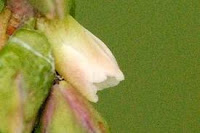Parsley piert is a tiny plant that can be easily overlooked in its wild habitat, as it grows only to around four inches high. It is no relation to true parsley, but its leaves look similar. It is a close relation to Lady’s Mantle, hence the name Lady’s Field Mantle, and is a member of the Rosaceae or rose family of plants. That being so it is also related to the soft fruit, plums, peaches, apricots, loquats, sloes, quinces, blackberries, strawberries, raspberries as well as to almonds, apples, pears, the dog rose and a whole host of other plants.
 It is native to
It is native to “The root, although it be very small and thready, yet it continues many years, from which arise many leaves lying along on the ground, each standing upon a long small foot-stalk, the leaves as broad as a man's nail, very deeply dented on the edges, somewhat like a parsley-leaf, but of a very dusky green colour. The stalks are very weak and slender, about three or four fingers in length, set so full of leaves that they can hardly be seen, either having no foot-stalk at all, or but very short; the flowers are so small they can hardly be seen, and the seed as small as may be.”
 It was a popular remedy for dispersing gravel and stones in the body’s organs, and eaten as a salad green as it is a useful source of vitamin C and minerals. It gets the name parsley piert from the French, perce-pierre which means piercing stones, and this is a name for it in English too, Parsley Breakstone or Parsley Piercestone. Here is what Nicholas Culpeper wrote about it in his 17th century herbal: -
It was a popular remedy for dispersing gravel and stones in the body’s organs, and eaten as a salad green as it is a useful source of vitamin C and minerals. It gets the name parsley piert from the French, perce-pierre which means piercing stones, and this is a name for it in English too, Parsley Breakstone or Parsley Piercestone. Here is what Nicholas Culpeper wrote about it in his 17th century herbal: -“Government and virtues. Its operation is very prevalent to provoke urine, and to break the stone. It is a very good sallad herb. It were good the gentry would pickle it up as they pickle up Samphire for their use all the Winter. I cannot teach them how to do it; yet this I can tell them, it is a very wholesome herb. They may also keep the herb dry, or in a syrup, if they please. You may take a dram of the powder of it in white wine; it would bring away gravel from the kidneys insensibly, and without pain. It also helps the stranguary.”
It was used with broom, pellitory-of-the-wall, juniper berries, parsley root (true parsley) for a more powerful diuretic action to remove gravel, and to soften the passage of the stones it was often combined with marsh mallow, hollyhock flowers, those of mullein, gum Arabic or slippery elm bark.
The infusion was made with a handful of the whole herb, chopped to one pint of boiling water, steeped for 10 minutes, then strained and drunk in half a tea cupful doses three or four times a day.
One scientific study has found that parsley piert is safe for human consumption and has “strong antioxidant activity.” (“Antioxidant and Cytotoxicity Activities of Aphanes arvensis Extracts” Journal of Plant Foods for Human Nutrition 2010, Vol. 65 (1) pp.44-49 Ismail Hamad et al.) However there have been few scientific studies carried out on this plant.


















